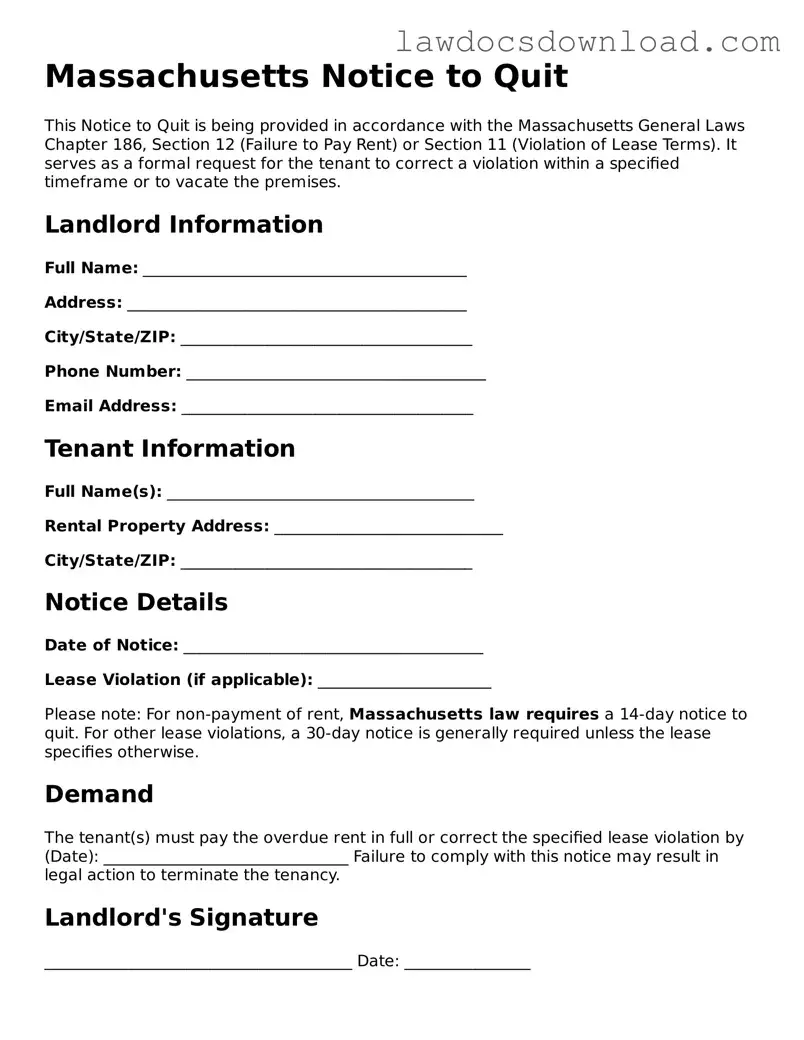What exactly is a Massachusetts Notice to Quit?
A Massachusetts Notice to Quit is a formal document that a landlord provides to a tenant to signal the termination of their tenancy. This notice serves as a preliminary step before pursuing eviction through the court system. It outlines the landlord's intention to reclaim possession of the property and specifies the reasons for the termination, whether it's for nonpayment of rent, violation of lease terms, or a no-fault scenario such as the landlord needing the property for personal use.
How does one determine the appropriate length of notice to give?
The length of notice required in Massachusetts primarily depends on the reason for eviction and the terms of the lease. For nonpayment of rent, a 14-day notice is typically required. For lease violations, the necessary notice might be 30 days, but this can vary based on the specific terms outlined in the lease agreement. It's crucial to review the agreement and consult legal guidelines to ensure the correct notice period is provided, aligning with state law and lease specifications.
Is it mandatory to use a specific form for the Notice to Quit in Massachusetts?
While Massachusetts law does not mandate a standardized form for the Notice to Quit, the notice must contain certain elements to be considered valid. These elements include the name of the tenant, the address of the rental property, the reason for the notice, and the date the tenancy will terminate. Although not required, using a form that covers all legal bases can help landlords ensure compliance with the law and avoid potential disputes.
Can a tenant remedy the situation after receiving a Notice to Quit?
Yes, tenants often have the opportunity to remedy the situation after receiving a Notice to Quit, particularly in cases of nonpayment of rent or curable lease violations. For example, if the notice is issued due to unpaid rent, tenants might be able to avoid eviction by paying the full amount due by a specified deadline. Similarly, correcting a lease violation within the given timeframe might also result in the termination notice being rescinded. Tenants should communicate directly with their landlords to understand if and how they can address the issues at hand.
What happens if a tenant does not leave by the specified date on the Notice to Quit?
If a tenant fails to vacate the property by the date specified in the Notice to Quit, the landlord may proceed with filing an eviction lawsuit, known as a Summary Process action, in court. This legal process requires the landlord to provide evidence supporting the eviction, and the tenant has the right to present their defense. It is only after the court approves the eviction that the landlord can legally reclaim possession of the property, potentially with the assistance of a law enforcement officer.
Does the Notice to Quit need to be delivered in a specific manner?
The delivery of the Notice to Quit, also referred to as "service," must be done in accordance with state law to be legally enforceable. Common methods of delivery include handing it directly to the tenant, leaving it with a resident of suitable age at the property, or mailing it via certified or registered mail to ensure there's a record of receipt. The method chosen can affect the timing of the eviction process, and landlords should verify which methods are legally acceptable and most effective for their situation.
Are there any scenarios where a Notice to Quit is not necessary?
There are limited scenarios in Massachusetts where a landlord might not need to provide a Notice to Quit before proceeding with eviction actions. These exceptions typically involve severe lease violations that pose an immediate threat to safety or the property itself, such as illegal activities. However, because these situations are exceptions and not the rule, seeking legal advice to navigate the complexities of eviction without notice is strongly recommended.
What are the next steps after a Notice to Quit is issued?
After issuing a Notice to Quit, the landlord must wait until the notice period expires. If the tenant fails to address the issue (pay rent, remedy a lease violation) or vacate the premises, the landlord's next step is to file a Summary Process (eviction) complaint with the appropriate court. This initiates the legal eviction process, which involves court hearings where both parties can present their case. Throughout this process, it's essential for both landlords and tenants to be aware of their rights and responsibilities, maybe even seeking legal representation to navigate the proceedings effectively.
